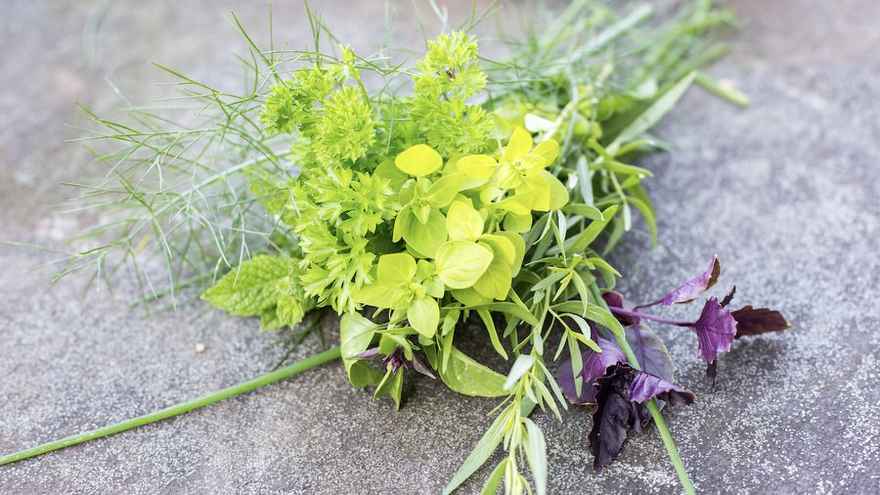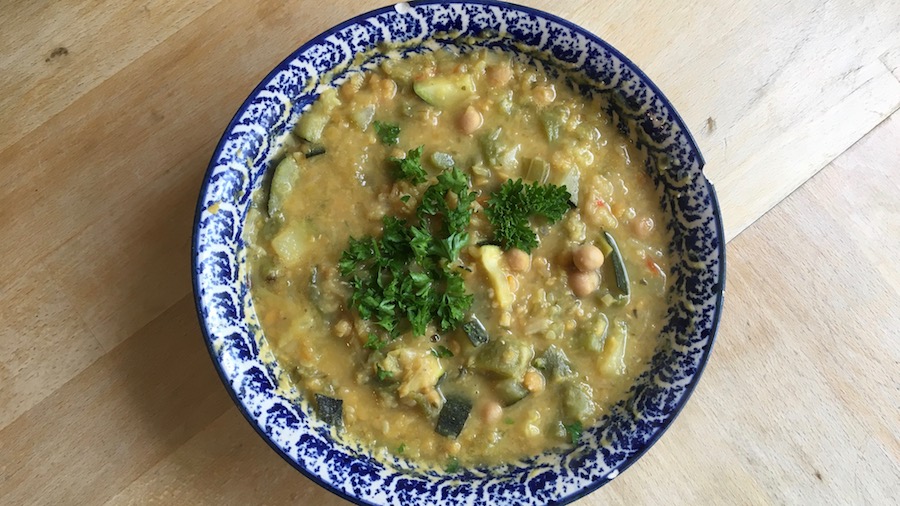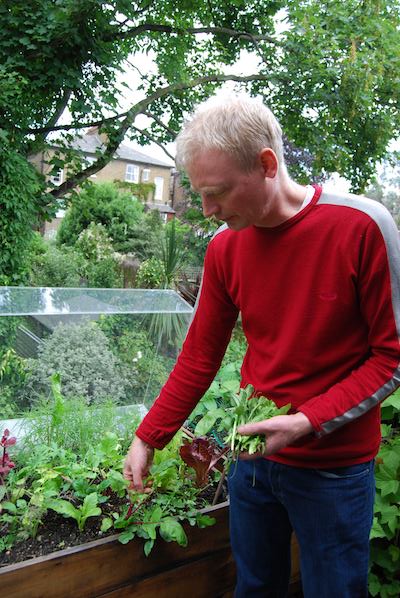Nutrition: Five ways to eat better from your container garden

Home grown food is delicious and rewarding to grow. But can growing containers in actually help you eat a more nutritious, healthier diet?
When you grow your own at home, everything you pick will be fresher than supermarket veg, you’ll be able to grow highly nutritious (and highly perishable) foods like microgreens and berries, and you can eat a more diverse diet, including herbs and leaves that you can’t easily buy.
But perhaps the biggest benefit is that you’ll be able to connect more closely with your food. You'll pick food direct from the plants: a multi scensory experience of touch and smell, completely different from handling shrink wrapped packaging in the supermarket isle. Your body will learn what fresh, nutritious food tastes like - and how it makes you feel.
Even if you only have time and space to grow a few trays of micro greens, you can get some of the benefits of growing your own, and add variety and valuable nutrients to your diet.
Here are five ways small space veg growing at home can help you eat better.
1. Help you eat more veg and fruit
Doctors and governments tell us we need to eat more fruit and veg. In the UK it’s been estimated that if we all ate ten portions of fruit and veg a day it would save 7.9 million premature deaths. But how many people actually manage to eat ten portions? Some recent figures suggest that two thirds of adults in the UK don't even eat five portions.
It's not alway easy to consume a lot of fresh food - and it can be expensive. When you grow your own at home it's easier to eat more fresh veg because it is always at hand on your doorstep, and it simply tastes so much better.
When it tastes better you want more. I’ve always liked salad but a homegrown salad - full of different leaves, edible flowers and herbs - bursts with flavour. I know many people who get addicted to it. If you haven’t got much time or space, even a few microgreens can change a bland supermarket lettuce into something super tasty.

You can get addicted to homegrown salad. This is a winter salad - with colours and intensity of flavour it is hard to buy.
Fresh, home grown herbs like mint and basil are nutritious in their own right. And they also transform other healthy foods, like hearty grains, into a meal of fine flavour. Fresh thyme, bay, and parsley can make the difference between a bland homemade soup and a delicious one.
Of course you can buy herbs. But having your own ‘larder of living herbs’ on your doorstep makes it a lot easier, makes 'healthy' vegetarian meals taste great, and saves you a small fortune on packs of fresh herbs from the shops.
If you start eating homemade soup and / or salad for lunch, plus veg and / or another salad for supper, the veg portions quickly add up. Before I started growing, I was only eating 3- 5 portions a day. But now I find I eat a lot more, often ten portions a day. I'm not alone - there is clear evidence that people who grow do indeed eat more fruit and veg - see this Sustain publication for example.

Veg portions can quickly add up: soup with homegrown courgette, runner beans, tomatoes, chilli, parsley, savory, lovage, bay. Plus bought lentils, onions, garlic, chickpeas.
2. Diversify your diet
There are over 20,000 edible plants in the world, yet fewer than 20 species now account for 90% of our food (Plants for a Future). Most nutritionists agree that a healthy diet should be made up of a more diverse range of fruit and veg.
By growing your own, you can easily expand the range of vegetables and fruit you eat. Browse any good seed catalogue and you’ll see hundreds of different leafy vegetables that you won’t find in the supermarket.
For example, every year I grow landcress, several varieties of mustard, sorrel, nasturtium leaves, purslane, orach, oyster plant, sunflower shoots, fava shoots, and New Zealand Spinach in containers in my front yard. Most of these I’ve never seen in the shops.

Just picked: a typical home grown salad of nasturtium leaves, mint, tarragon, garlic chives, oregano, beetroot leaf, society garlic flowers, sorrel and watercress. The combinations and possibilities are limitless.
As well as all the common herbs I grow lovage, chervil, fennel, Vietnamese coriander, myrtle, lemon verbena and savory. And I have edible flowers like viola, nasturtium, and society garlic. And Japanese wineberries, honey berries, and Chilean guavas. I grow several varieties of kale (anyone tried asparagus kale?), cucumbers that actually have flavour, and heritage varieties of beans, tomatoes and squash as well as unusual vegetables like fat baby achocha, mouse melons, and raab broccoli.
All these - and many more - can be easily be grown in containers. And, again, even if you just grow a few trays of microgreens you could still add ten or more different leaves to your regular diet.

Chilean guavas are unusual, tasty and easy to grow in containers.
3. Eat fresher food
The nutrients in most food begin to degrade immediately after picking. Travel, refrigeration, handling and storage further reduce nutrient content. Leafy veg in particular can lose nutrients fast. A study by Penn State found spinach lost nearly half (47%) of its vitamin content in just six days.
By growing food on your windowsills or patio you’ll be eating food minutes after picking it. And you’ll probably notice that freshly picked leaves and tomatoes sing with flavour. It might come as no surprise that there is a clear relationship between flavour and nutritional content. A study on tomatoes, for example, found that all the important flavours are derived from essential nutrients (S Goff, H Klee, 2006). So those home grown tomatoes that burst with flavour are full of goodness, too.
Picking your own salad is a completely different experience to buying it in the supermarket - and you'll be eating minutes after picking. You can't get fresher than that.
4. Eat more nutritious foods
The concept of ‘superfoods’ was largely dreamt up as a marketing ploy so it’s wise to treat such claims with caution. Diversity is more important - and there are so many healthy, nutritious foods that can be grown in containers.
However, if you are looking for a place to start, the following selection are easy to grow in containers and are particularly nutritious. Many thanks to independent nutrition expert, Elizabeth Quinn, from ThirdPlanetFood whose advice much of this list is based on.
- Peashoots and most other micro greens. Studies suggest that microgreens are more nutrient dense than full sized plants - by as much as 4 - 40 times. 2 cups of pea shoots have 35% of your daily Vitamin C, 100% Vitamin K, and are also high in folates and protein (and contain only 10 calories), according to Elizabeth Quinn.
- Kale - vitamin and mineral rich and a cruciferous vegetable (cruciferous vegetables are associated with health benefits as they are rich in fibre, vitamins and sulphur).
- Swiss Chard - contains vitamins, calcium, iron, magnesium, important antioxidants and is also a cruciferous vegetable.
- Berries are high in anthocyanin and anti-oxidants - blueberries, blackberries, raspberries, strawberries and most other berries.
- Sprouts - eg lentil, brocooli and bean sprouts.
Another interesting choice is artichokes (both Jerusalem and globe) as these have been shown to be excellent 'prebiotics' (good for the all important bacteria in your gut). In big containers Jerusalem artichokes are easy and productive - and globe artichokes look magnificent.
5. Accessing quality, affordable veg
More and more cities now have 'urban food deserts', areas where it is hard to buy fresh, quality veg, particularly on a tight budget. While growing your own does not always save money, it is possible to grow high quality produce at a fraction of what a similar quality would cost. Particularly if you use recycled containers, make your own worm compost for fertiliser, and grow high value crops like herbs and microgreens. When you grow your own you can also be assured of the quality. You'll know what has and hasn't gone it - and you can avoid the use of all pesticides and artificial fertilisers.
Can growing in small spaces help change our food culture?
It's easy to get depressed by how dysfunctional our current food system is: supermarket isles lined with crisps and processed foods, cakes to tempt us in every coffee shop, breakfast cereals packed with sugar and heavily marketed to kids. It's no wonder that a lot of our current health problems (and costs) are caused by what we eat.
So can something as simple as growing food in containers make any difference? Of course we need many changes to our food system, but I do believe that growing more food in the city will help inspire change. By growing at home, we can eat a more diverse selection of fresher and more nutritious fruit and veg. And we can also connect and engage more deeply with our food again, opening more eyes to current sorry state of food.
I believe that growing food in the small nooks and crannies of our cities has the potential to help change our food culture. And the more of us who do it, the quicker a tipping point will be reached.
More information
If you want more information on nutrition, from a source that is not selling a diet product or training programme, my favourite website is Thought for Food, an excellent blog by Annemieke Wigmore (her monthly emails are also recommended). Michael Pollan's books are good (and entertaining), as is The Diet Myth by Tim Spector.
Your turn
If you are growing some of your own, has it influenced how you eat? Has growing helped you make any changes to what you eat? Do you have any favourite 'healthy' crops to grow? I'd love to hear from you in the comments.


10 comments
Leave a comment